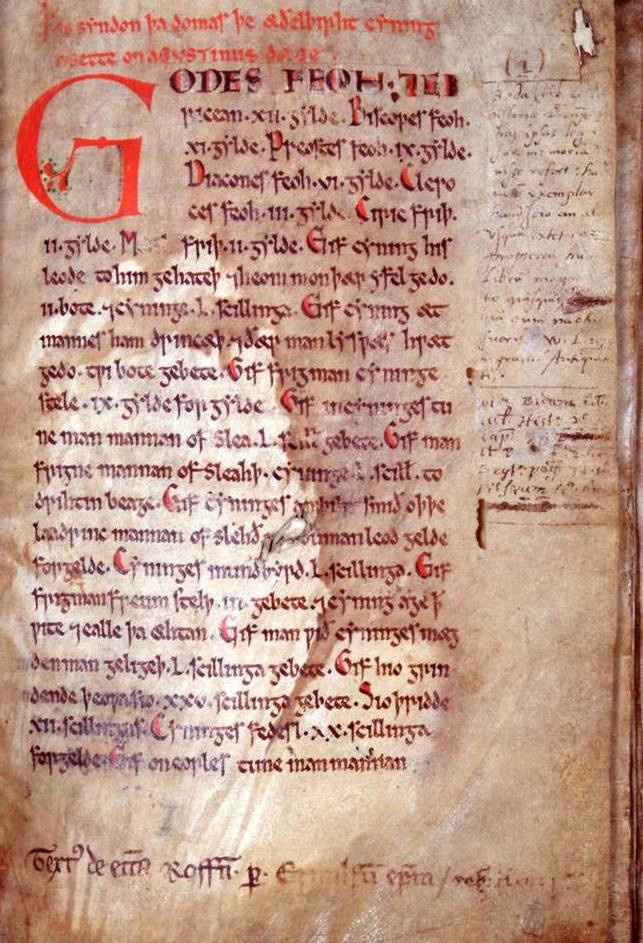|
Handhabend
In Anglo-Saxon law, backberend (also spelled backberende or back-berande) and handhabend (also spelled hand-habend or hand-habende) were terms applied to a thief who was found having the stolen goods in his possession. The terms are respectively derived from "bearing thingupon the back" and "having thingin the hand".John Bouvier, ''A Law Dictionary, Adapted to the Constitution and Laws of the United States of America'', J. B. Lippincott & Co., Philadelphia, 15th ed., 1883. The thief himself was a hontfongenethef, meaning "a thief taken with handhabend"; i.e., captured while holding the stolen item in his hand, later described as "red-handed".Henry C. Black, ''Black's Law Dictionary'', 4th ed. 1968. By extension, ''handhabend and backberend'' also means the jurisdiction to try a thief caught with the property in question. A thief so caught could be given a trial of a more summary nature.'' Laws of Henry I'', chap. 59; Laws of Aethelstane, § 6; Fleta, ''lib.'' 1, chap. 38, ... [...More Info...] [...Related Items...] OR: [Wikipedia] [Google] [Baidu] |
Halifax Gibbet
The Halifax Gibbet was an early guillotine used in the town of Halifax, West Yorkshire, England. Estimated to have been installed during the 16th century, it was used as an alternative to beheading by axe or sword. Halifax was once part of the Manor of Wakefield, where ancient custom and law gave the Lord of the Manor the authority to execute summarily by decapitation any thief caught with stolen goods to the value of 13 d or more (), or who confessed to having stolen goods of at least that value. Decapitation was a fairly common method of execution in England, but Halifax was unusual in two respects: it employed a guillotine-like machine that appears to have been unique in the country, and it continued to decapitate petty criminals until the mid-17th century. The device consisted of an axe head fitted to the base of a heavy wooden block that ran in grooves between two uprights, mounted on a stone base about high. A rope attached to the block ran over a pulley, allowing it ... [...More Info...] [...Related Items...] OR: [Wikipedia] [Google] [Baidu] |
Anglo-Saxon Law
Anglo-Saxon law ( Old English ''ǣ'', later ''lagu'' "law"; dōm "decree, judgment") is a body of written rules and customs that were in place during the Anglo-Saxon period in England, before the Norman conquest. This body of law, along with early Medieval Scandinavian law and Germanic law, descended from a family of ancient Germanic custom and legal thought. However, Anglo-Saxon law codes are distinct from other early Germanic legal statements—known as the ''leges barbarorum'', in part because they were written in Old English instead of in Latin. The laws of the Anglo-Saxons were the second in medieval Western Europe after those of the Irish to be expressed in a language other than Latin. Overview Early Germanic law Inked records of early Germanic law (''leges barbarorum'') were, in many ways, the product of Roman influence. Throughout the early middle ages, as various " Teutonic", or Germanic, tribes on the continent came into closer and more peaceful contact with the h ... [...More Info...] [...Related Items...] OR: [Wikipedia] [Google] [Baidu] |
Jurisdiction
Jurisdiction (from Latin 'law' + 'declaration') is the legal term for the legal authority granted to a legal entity to enact justice. In federations like the United States, areas of jurisdiction apply to local, state, and federal levels. Jurisdiction draws its substance from international law, conflict of laws, constitutional law, and the powers of the executive and legislative branches of government to allocate resources to best serve the needs of society. International dimension Generally, international laws and treaties provide agreements which nations agree to be bound to. Such agreements are not always established or maintained. The exercise of extraterritorial jurisdiction by three principles outlined in the UN charter. These are equality of states, territorial sovereignty and non-intervention. This raises the question of when can many states prescribe or enforce jurisdiction. The ''Lotus'' case establishes two key rules to the prescription and enforcement of ... [...More Info...] [...Related Items...] OR: [Wikipedia] [Google] [Baidu] |
Leges Henrici Primi
The ''Leges Henrici Primi'' or ''Laws of Henry I'' is a legal treatise, written in about 1115, that records the legal customs of medieval England in the reign of King Henry I of England. Although it is not an official document, it was written by someone apparently associated with the royal administration. It lists and explains the laws, and includes explanations of how to conduct legal proceedings. Although its title implies that these laws were issued by King Henry, it lists laws issued by earlier monarchs that were still in force in Henry's reign; the only law of Henry that is included is the coronation charter he issued at the start of his reign. It covers a diverse range of subjects, including ecclesiastical cases, treason, murder, theft, feuds, assessment of danegeld, and the amounts of judicial fines. The work survives in six manuscripts that range in date from about 1200 to around 1330, belonging to two different manuscript traditions. Besides the six surviving manuscrip ... [...More Info...] [...Related Items...] OR: [Wikipedia] [Google] [Baidu] |
Felony
A felony is traditionally considered a crime of high seriousness, whereas a misdemeanor is regarded as less serious. The term "felony" originated from English common law (from the French medieval word "félonie") to describe an offense that resulted in the confiscation of a convicted person's land and goods, to which additional punishments including capital punishment could be added; other crimes were called misdemeanors. Following conviction of a felony in a court of law, a person may be described as a felon or a convicted felon. Some common law countries and jurisdictions no longer classify crimes as felonies or misdemeanors and instead use other distinctions, such as by classifying serious crimes as indictable offences and less serious crimes as summary offences. In the United States, where the felony/misdemeanor distinction is still widely applied, the federal government defines a felony as a crime punishable by death or imprisonment in excess of one year. If punishable b ... [...More Info...] [...Related Items...] OR: [Wikipedia] [Google] [Baidu] |

